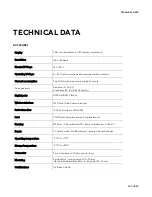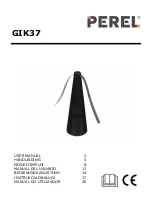
SAFETY INFORMATION
B000882
•
When working underneath the vehicle, secure it
according to the specifications from the vehicle
manufacturer.
•
Note the necessary clearance behind the drill hole or
port at the installation location. Required mounting
depth: 65 mm.
•
Drill small ports; enlarge and complete them, if
necessary, using taper milling tools, saber saws, keyhole
saws or files. Deburr edges. Follow the safety
instructions of the tool manufacturer.
•
Use only insulated tools, if work is necessary on live
parts.
•
Use only the multimeter or diode test lamps provided,
to measure voltages and currents in the
vehicle/machine or boat. Use of conventional test
lamps can cause damage to control units or other
electronic systems.
•
The electrical indicator outputs and cables connected
to them must be protected from direct contact and
damage. The cables in use must have enough
insulation and electric strength and the contact points
must be safe from touch.
•
Use appropriate measures to also protect the
electrically conductive parts on the connected
consumer from direct contact. Laying metallic,
uninsulated cables and contacts is prohibited.
SAFETY AFTER INSTALLATION
•
Connect the ground cable tightly to the negative
terminal of the battery.
•
Reenter/reprogram the volatile electronic memory
values.
•
Check all functions.
•
Use only clean water to clean the components. Note
the Ingress Protection (IP) ratings (IEC 60529).
ELECTRICAL CONNECTION
•
Note cable cross-sectional area!
•
Reducing the cable cross-sectional area leads to higher
current density, which can cause the cable cross-
sectional area in question to heat up!
•
When installing electrical cables, use the provided
cable ducts and harnesses; however, do not run cables
parallel to ignition cables or to cables that lead to large
electricity consumers.
•
Fasten cables with cable ties or adhesive tape. Do not
run cables over moving parts. Do not attach cables to
the steering column!
•
Ensure that cables are not subject to tensile,
compressive or shearing forces.
•
If cables are run through drill holes, protect them using
rubber sleeves or the like.
•
Use only one cable stripper to strip the cable. Adjust
the stripper so that stranded wires are not damaged or
separated.
•
Use only a soft soldering process or commercially
available crimp connector to solder new cable
connections!
•
Make crimp connections with cable crimping pliers
only. Follow the safety instructions of the tool
manufacturer.
•
Insulate exposed stranded wires to prevent short
circuits.
•
Caution: Risk of short circuit if junctions are faulty or
cables are damaged.
•
Short circuits in the vehicle network can cause fires,
battery explosions and damages to other electronic
systems. Consequently, all power supply cable
connections must be provided with weldable
connectors and be sufficiently insulated.
•
Ensure ground connections are sound.
•
Faulty connections can cause short circuits. Only
connect cables according to the electrical wiring
diagram.
•
If operating the instrument on power supply units, note
that the power supply unit must be stabilized and it
must comply with the following standard: DIN EN
61000, Parts 6-1 to 6-4.
Summary of Contents for VL FLEX 52 INDUSTRIAL
Page 1: ...B000882 VL FLEX 52 OPERATING INSTRUCTIONS rev AA EN DE IT FR ES PT ...
Page 22: ...B000882 VL FLEX 52 BEDIENUNGSANLEITUNG rev AA EN DE IT FR ES PT ...
Page 44: ...B000882 VL FLEX 52 ISTRUZIONI PER L USO rev AA EN DE IT FR ES PT ...
Page 66: ...B000882 VL FLEX 52 MODE D EMPLOI rev AA EN DE IT FR ES PT ...
Page 88: ...B000882 VL FLEX 52 INSTRUCCIONES PARA EL USO rev AA EN DE IT FR ES PT ...





































